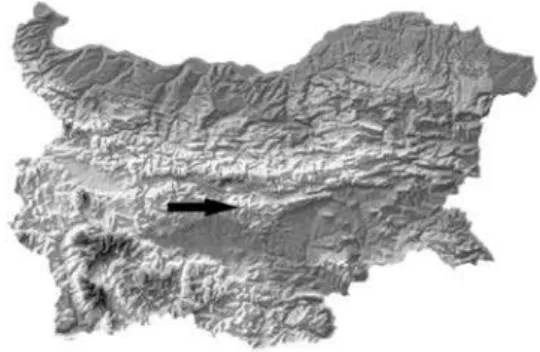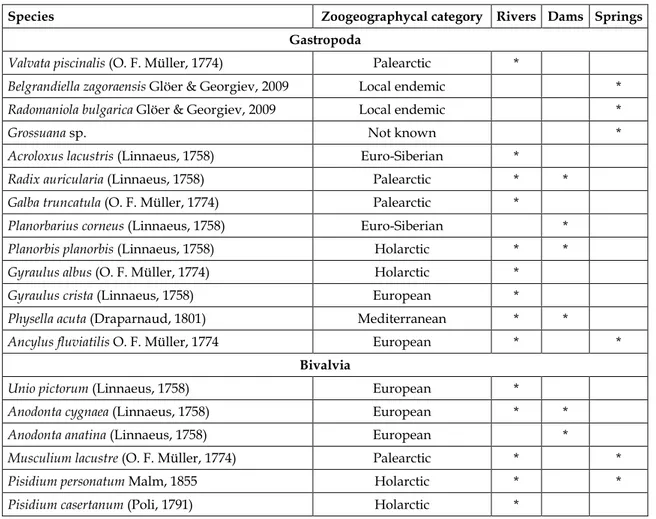© Ecologia Balkanica
http://eb.bio.uni-plovdiv.bg
Union of Scientists in Bulgaria – Plovdiv University of Plovdiv Publishing House
ECOLOGIA BALKANICA
2012, Vol. 4, Issue 1 June 2012 pp. 107-110
Short note
Updated Information on the Habitat Distribution and Diversity of
the Freshwater Malacofauna of Sarnena Gora Mountain (Bulgaria)
Dilian G. Georgiev
University of Plovdiv, Faculty of Biology, Department of Ecology and Environmental Conservation, 24, Tzar Assen Str., BG-4000 Plovdiv, BULGARIA
Corresponding author: diliangeorgiev@abv.bg
Abstract: According to the recent research and the critical overview of the literature it can be summarized that a total of 13 species of freshwater snails and 6 species of mussels are known to occur in Sarnena Gora Mountain. The highest richness of freshwater molluscs species in the surveyed area were found in the medium sized rivers having microhabitats favorable for the aquatic molluscs such as fast flowing oligotrophic stretches combined with slow moving eutrophic parts and small floods on the banks. The species community of the freshwater molluscs known to live in the mountain studied was consisted mainly by some widely distributed species with Holarctic and Palearctic distributions, followed by the European species. Two local endemics were also registered in the mountain.
Key words: aquatic molluscs,Gastropoda, Bivalvia, habitat distribution, zoogeography, Bulgaria. Introduction
The first information on the freshwater malacofauna of Sarnena Gora Mountain (a part of Sredna Gora Mountain ridge) was given by GEORGIEV (2005) who reported 12 species of aquatic snails and 4 species of mussels. Later on, some additional information was given by GEORGIEV & STOYCHEVA (2009) reporting of Anodonta anatina (Linnaeus, 1758) from a pond in the Starozagorski Bani resort. Two new species of Hydrobiidae (Gastropoda) were des-cribed as new from the Sarnena Gora Mountain by GLÖER &GEORGIEV (2009), i.e.,
Belgrandiella zagoraensis Glöer & Georgiev, 2009 and Radomaniola bulgarica Glöer & Georgiev, 2009 (wrongly reported by GEORGIEV (2005) as Bythinella austriaca
(Frauenfeld, 1857), and Pseudamnicola
consociella euxina Wagner, 1927,
respectively).
The aim of this study was: (i) to revise, summarize and update the information on
the freshwater malacofauna of Sarnena Gora Mountain according to its species diversity and habitat distribution, and (ii) to provide some additional analysis of its zoogeo-graphical structure.
Material and methods
The massif of Sarnena Gora Mt (size around 5950 km2) is situated between 25°
and 26° meridians, and south of the central parts of Stara Planina Mt, from which it is separated by the Kazanlashka valley. From south and east it borders with the Upper Thracian Lowland, and from west with the Sashtinska Sredna Gora Mt (Fig. 1).
Updated Information on the Habitat Distribution and Diversity of the Freshwater Malacofauna…
108
ethanol. The shells were collected by sieving river deposits by 1x1 and 2x2 mm mesh width sieves. The dissections and measurements were carried out by means of CETI stereo microscope and an eye-piece micrometre for the needs of species determination. The nomenclature, species determinations and zoogeographical categories followed GLÖER (2002), GLÖER & MEIER-BROOK (2003) and ANGELOV (2000).
Fig. 1. Position of Sarnena Gora Mountain, pointed by an arrow.
Results and Discussion
1. Species diversity
According to the synopsis and the critical overview of the literature it can be summarized that a total of 13 species of freshwater snails and 6 species of mussels are known to occur in Sarnena Gora Mountain (Table 1).
Misidentified species. The following species were considered as wrongly reported for the area during previous studies: Bythinella austriaca, Pseudamnicola consociella euxina, Radix ovata (Draparnaud, 1801), and Planorbis carinatus O. F. Müller, 1774, and according to our revision refer to:
Belgrandiella zagoraensis, Radomaniola bulgarica and/or Grossuana sp., Radix auricularia (Linnaeus, 1758), and Planorbis planorbis (Linnaeus, 1758), respectively.
New records for the study area. The species Gyraulus crista (Linnaeus, 1758) and
Pisidium personatum Malm, 1855 were reported for the first time at the Sarnena Gora Mountain during present study. These species were collected as empty shells in Bedechka river near Stara Zagora city. Also
an unidentified species of Grossuana
Radoman, 1973 was found to live together with Belgrandiella zagoraensis at the mountain foothills from springs were the latter species was described (GLÖER & GEORGIEV, 2009).
2. Habitat distribution
In the paper of GEORGIEV (2005) some spring-dwelling species as the representatives of the Rissooidea superfamily, were erroneously reported from rivers, where they were found by empty shells in the alluvium. Same unsure records were reported and for the empty shells of other snails found in rivers, springs, and canals (which could live in other habitats but were transported there by floods as empty shells), which was corrected during present synopsis.
Most rich on species in the mountain were the medium sized rivers (14 species). The micro dams and the springs had 6 species each. The canals reported in GEORGIEV (2005) were omitted in this study because were considered as a temporary habitat with uncertain living mollusc fauna.
The species Acroloxus lacustris
(Linnaeus, 1758) prefers stagnant waters (ANGELOV, 2000) but was not found in the micro dams during present study, so its presence in this habitat could be supposed. Also the euribiotic wide spread in Bulgaria (ANGELOV, 2000) species as Physella acuta
(Draparnaud, 1801), Galba truncatula (O. F. Müller, 1774), and Radix auricularia could be expected in springs or other habitats in the area, where they were not registered. The river mussel Unio pictorum (Linnaeus, 1758) is known to live and in clean standing waters (ANGELOV, 2000) so its finding in the small dams of Sarnena Gora is possible.
3. Zoogeography
Dilian G. Georgiev
109
Table 1. Species diversity, habitat distribution and zoogeographical categories of the freshwater malacofauna of Sarnena Gora Mountain.
Species Zoogeographycal category Rivers Dams Springs Gastropoda
Valvata piscinalis (O. F. Müller, 1774) Palearctic *
Belgrandiella zagoraensis Glöer & Georgiev, 2009 Local endemic *
Radomaniola bulgarica Glöer & Georgiev, 2009 Local endemic *
Grossuana sp. Not known *
Acroloxus lacustris (Linnaeus, 1758) Euro-Siberian *
Radix auricularia (Linnaeus, 1758) Palearctic * *
Galba truncatula (O. F. Müller, 1774) Palearctic *
Planorbarius corneus (Linnaeus, 1758) Euro-Siberian *
Planorbis planorbis (Linnaeus, 1758) Holarctic * *
Gyraulus albus (O. F. Müller, 1774) Holarctic *
Gyraulus crista (Linnaeus, 1758) European *
Physella acuta (Draparnaud, 1801) Mediterranean * *
Ancylus fluviatilis O. F. Müller, 1774 European * *
Bivalvia
Unio pictorum (Linnaeus, 1758) European *
Anodonta cygnaea (Linnaeus, 1758) European * *
Anodonta anatina (Linnaeus, 1758) European *
Musculium lacustre (O. F. Müller, 1774) Palearctic * *
Pisidium personatum Malm, 1855 Holarctic * *
Pisidium casertanum (Poli, 1791) Holarctic *
Updated Information on the Habitat Distribution and Diversity of the Freshwater Malacofauna…
© Ecologia Balkanica
http://eb.bio.uni-plovdiv.bg
Union of Scientists in Bulgaria – Plovdiv University of Plovdiv Publishing House
References
ANGELOV A. 2000. Mollusca (Gastropoda et Bivalvia) aquae dulcis, Catalogus Faunae Bulgaicae. Pensoft & Backhuys Publ., Sofia, Leiden, 54 p.
GEORGIEV D., 2005. Species diversity and
habitat distribution of the Malacofauna (Mollusca: Bivalvia, Gastropoda) of Surnena Sredna Gora Mountain (Southern Bulgaria). - In: Gruev B., M. Nikolova, A. Donev (Eds.), Balkan Scientific Conference of Biology, Proceedings, 19-21 May, Plovdiv, Bulgaria: 428-435.
GEORGIEV D., S. STOYCHEVA 2009. The molluscs and their habitats in Sashtinska Sredna Gora Mts. (Southern Bulgaria). – Malacologica Bohemoslovaca, 8: 1–8.
GLÖER P., D. GEORGIEV 2009. New Rissooidea from Bulgaria (Gastropoda: Rissooidea). – Mollusca, 27(2): 123-136. GLÖER P. 2002. Die Süsswassergastropoden
Nord- und Mitteleuropas. ConchBooks Publishing, 327 p.
GLÖER P., C. MEIER-BROOK 2003.
Süsswassermollusken – Ein Bestimmungsschlüssel für die Bundesrepublik Deutschland. Deutscher Jugendbund für Naturbeobachtung (Hrsg.), Hamburg, 13. neubearbeitete, Auflage, 134 p.

